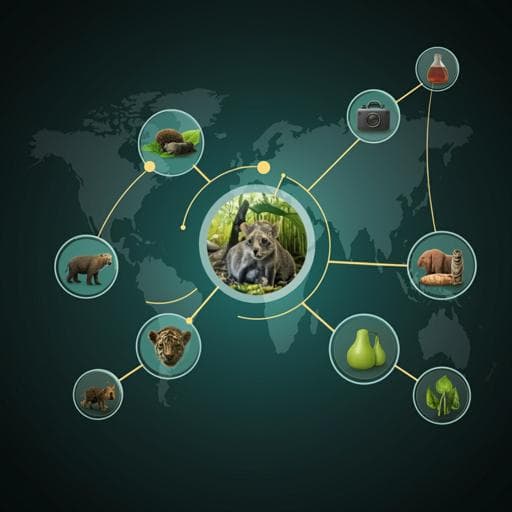
Biology
Early warning of trends in commercial wildlife trade through novel machine-learning analysis of patent filing
A. Hinsley, D. W. S. Challender, et al.
This groundbreaking study by A. Hinsley and colleagues unveils the unforeseen impact of unsustainable wildlife trade on innovation and market shifts. With a staggering 130% annual rise in patents related to endangered species from 1970 to 2020, it reveals how businesses are adapting with novel products and methods despite stricter regulations. Discover how this research leverages machine learning to provide essential insights for proactive wildlife trade management!
~3 min • Beginner • English
Introduction
The study addresses how to proactively detect and manage emerging threats from commercial wildlife trade, which contributes to global biodiversity loss and has links to public health and animal welfare. Traditional approaches rely on historical trade data and are reactive, while wildlife markets evolve rapidly through innovation, regulatory changes, and shifting consumer preferences. The authors propose that patent filings can serve as an early-warning indicator of commercial innovation and market shifts in wildlife-derived products. They hypothesise: (1) in mature markets (e.g., traditional Chinese medicine), product innovation enables differentiation and superior returns; (2) regulation that restricts access to wild products will shape innovation either towards compliance or avoidance; (3) the legalisation of patenting TCM products in China from 1993 catalysed innovation; and (4) the evolution of patent content reveals business expectations about the future of wildlife markets, including potential legalisation or shifts to farmed/synthetic alternatives. The study spans 1970–2020, covering major regulatory changes (e.g., CITES) and global growth in patenting, notably in China.
Literature Review
Prior work has used manual patent analysis to examine access and benefit sharing for marine genetic resources and to explore diversification in uses of wild orchids, indicating patents can reflect commercial interest and innovation trajectories. Broader wildlife trade research documents market dynamics, regulatory impacts (including sometimes counterintuitive effects of bans), substitution among species, and the emergence of farmed or synthetic alternatives. Economic and management literature suggests innovation strategies in competitive markets and how regulation can influence innovation paths, including compliance-driven innovation and avoidance entrepreneurship. The legal change enabling patenting of TCM in China since 1993 is highlighted as a structural shift likely to influence patenting behaviour. Analogies are drawn to marijuana patenting in the U.S., where patent activity anticipated legal changes.
Methodology
Case selection: From an initial long-list of commercially traded wild taxa with relevant regulatory or non-regulatory interventions, six focal groups were selected to cover diverse product types, geographies, and regulation: bears (bile), caterpillar fungus (Cordyceps/Ophiocordyceps), horseshoe crabs (blood and bait), pangolins (scales, meat), rhinoceroses (horn), and sturgeon (caviar, meat). Timeframe: 1970–2020. Keyword strategy: Initial English, Latin, and key local-language names were compiled for each taxon, assuming relevant patents include taxon names even when addressing substitutes/synthetics. A random sample of 200 patents was manually reviewed to refine search terms, remove false positives (e.g., pangolin gene in Drosophila), and add exclusions to reduce translation errors and irrelevant matches. Final keyword lists per taxon (including negative filters) are reported in Table 3 of the paper. Data acquisition: Public patent data were scraped via Google Patents using selenium (rselenium). The scraper collected metadata (filers, inventors, priority dates), abstracts, and full descriptions. The initial dataset comprised 27,308 patents across 35 search terms for the six taxa. Data cleaning: Duplicates and irrelevant items were removed through manual filtering. Filing rate trends: Year-on-year percentage change (Jan–Dec) in patent counts was calculated for global patents and focal taxa from 1985 (the first year all taxa had at least one filing) to Dec 2020, ignoring years with zero patents. Changepoint analysis: Monthly filing counts were modeled with a Bayesian changepoint approach using Stan (cmdstanr), with a negative binomial likelihood allowing overdispersed count data. Two parameterisations (pre- and post-changepoint) were fit; the changepoint parameter captured the most probable shift time. HMC settings: 4 chains, 2000 iterations, adapt_delta = 0.95; priors u=10 and o=1 (early and late). Convergence was assessed via traceplots and R-hat. Topic modeling: LDA was applied to patent abstracts to identify co-occurring themes, selecting topic numbers by balancing semantic coherence and exclusivity. Thematic coding: LDA topics were combined with a codebook adapted from the Economic Botany Data Collection Standard to define broad uses (medicine, food, agriculture, cosmetics) and processes (production/farming/cultivation, preparation/processing, detection/forensics) plus synthetics and alternatives. Keywords were derived from top non-generic LDA terms and Economic Botany terms; patents were labeled with one or more topics. Iterative manual review refined keywords, added topics, and corrected mislabels until all patents had at least one topic label. Comparative context: Global patent counts (1970–2020) were used as a background trend (118,393,322 patents).
Key Findings
Scale and growth: 27,308 patents related to the six taxa were filed between 1970–2020, against 118,393,322 patents globally. Mean increase in global patent filing (Jul 1988–Dec 2020) was 104%, while focal taxa increased at similar or higher rates: horseshoe crab 102%, sturgeon 129%, pangolin 130%, bear 115%, rhinoceros 149%, caterpillar fungus 143%. Median monthly filing rates across taxa rose from 0 (1970–1971) to between 1 (rhinoceros) and 46 (caterpillar fungus) per month in 2019–2020. Timing of first filings: horseshoe crab (1970), sturgeon (1971), bear (1977), caterpillar fungus (1978), pangolin (1980), rhinoceros (1988). Changepoints: bear (Mar 1992), caterpillar fungus (Aug 1992), pangolin (Aug 1995) — coincident with China allowing TCM patenting (1993); rhinoceros (Mar 2008) — coinciding with a surge in rhino poaching; horseshoe crab (Aug 1987) — aligned with FDA LAL guidance; sturgeon (Apr 2003) — following 2001 Caspian caviar export ban and 2002 CITES Resolution. Peaks in monthly filings: rhinoceros 53 (Jan 2013), pangolin 150 (Dec 2013), caterpillar fungus 485 (Dec 2015), bear 34 (Dec 2015), sturgeon 117 (Apr 2016), horseshoe crab 13 (Sep 2017). Regulation and patenting: Patenting often continued despite trade bans. All 526 rhinoceros-related patents were filed after the 1977 international commercial trade ban; 476 focused on products using rhino horn (not synthetics/farming), and 426 were filed in China after the 1993 domestic ban. Pangolin patenting continued to rise after some early CITES restrictions, but overall median monthly pangolin filings fell after the 2017 CITES Appendix I listing (median 81/month in 2014 to 31/month in 2017). Sturgeon and caterpillar fungus filings increased after key national restrictions (Caspian bans; Nepal harvest restrictions). Diversification: Innovation expanded product portfolios. Novel products emerged (e.g., rhino horn snuff; pangolin-scale livestock feed; electronics applications for horseshoe crab blood). However, established uses (e.g., bear bile medicines) still dominated patent volumes. Source diversification and alternatives: Farming vs synthetics counts — sturgeon (farming 1,190; synthetics 90), caterpillar fungus (farming 4,968; synthetics 2,412), bear (farming 59; synthetics 273), horseshoe crab (farming 90; synthetics 163), rhinoceros (farming 41; synthetics 27), pangolin (farming 44; synthetics 113; farming filings increased around the 2016 Appendix I listing announcement). Detection/forensics patents increased over time. Overall, only 9,470 patents (34.6%) referenced farmed or synthetic sourcing, indicating most innovation focused on expanding wildlife use rather than alternatives.
Discussion
Findings support the premise that patent data provide a proactive indicator of commercial interest and potential future market developments in wildlife-derived products. Patenting grew faster than global background rates for most taxa, including those subject to strict trade bans, indicating persistent commercial innovation and confidence. Regulatory impacts were heterogeneous: bans did not consistently reduce patenting (e.g., rhinoceros), potentially reflecting legal uncertainty and expectations of future legalisation, whereas broader enabling regulations (e.g., China’s 1993 allowance of TCM patenting) coincided with strong shifts in filing behaviour across taxa. Topic trends reveal diversification into novel products and sectors, suggesting future demand expansion (e.g., pangolin in agriculture). Increased filings for farming and synthetic methods in certain taxa signal anticipated market shifts toward non-wild sourcing, especially when bans are perceived as long-term and certain. The approach addresses the research question by demonstrating that patent filings can act as early-warning signals for emerging wildlife products and sourcing technologies, informing pre-emptive interventions, targeted enforcement, and engagement with industry. Policy implications include improving industry awareness of CITES and national rules, exploring mechanisms for patent offices to flag filings reliant on banned taxa for outreach, and prioritising interventions that incentivise innovation in sustainable alternatives.
Conclusion
This study introduces a machine-learning-led framework combining large-scale patent scraping, Bayesian changepoint detection, and topic modeling to anticipate trends in commercial wildlife trade. Across six focal taxa, patenting expanded substantially, diversified product use, and often persisted despite trade bans, with enabling regulations playing a major role in shifting innovation. Patent trends provide actionable early-warning signals for emerging products, sectors, and sourcing methods, enabling proactive conservation and trade management. Future work should include: periodic, in-depth patent analyses for priority taxa; automated, wide-spectrum patent surveillance across many species; keyword-based monitoring of sectors (e.g., TCM) to detect the emergence of new taxa; and focused scans following major shocks (regulatory changes, pandemics). Collaboration with businesses patenting alternatives is essential to ensure that innovations are commercially viable while meeting conservation and welfare goals.
Limitations
Causality cannot be inferred between exogenous events and observed changes in patenting; the analysis is correlational. Not all traded wildlife products are represented in patents, and not all patents result in commercialised products, potentially biasing inferences. Data scraping and multilingual keyword matching can introduce false positives/negatives and translation errors, requiring manual filtering. The study focuses on abstracts for topic modeling, which may omit technical detail present in full texts. Patent data are proprietary to filers and not openly shareable in full; results rely on aggregated analyses. Broader geopolitical and policy changes (e.g., national patenting incentives) may confound global trend comparisons.
Related Publications
Explore these studies to deepen your understanding of the subject.







